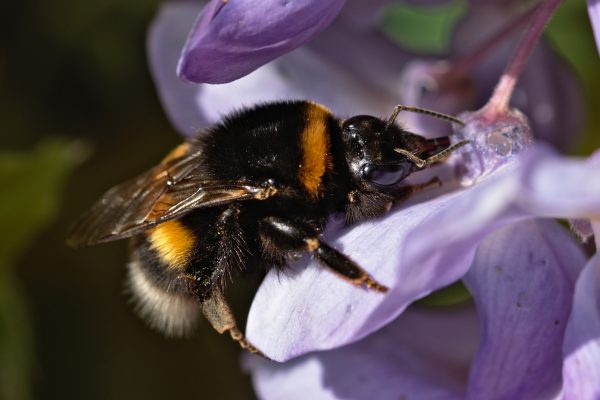
Some of Alaska’s most valuable pollinators are bumblebees and, it turns out, we have a lot of them. As bumblebees have declined in parts of the Lower 48, they’re apparently thriving in Alaska, even in the high Arctic.
But entomologists want to know more.
A new project to compile an Alaska bee atlas aims to give us a better understanding of how many bees there really are in Alaska, including the bumbles, which belong to the genus Bombus.
Gemma Tarlach is a senior editor and writer at Atlas Obscura. She wrote about Alaska’s bumblebees in a recent article, describing the bumblebees’ method of generating body heat by vibrating their muscles as “twerking.”
Tarlach is a beekeeper too, and she says that while honeybees are also valuable pollinators, the native bumblebees are particularly important to the ecosystem.
She recently spoke with Alaska Public Media’s Casey Grove about Alaska bees and the atlas project.
Listen here:
[Sign up for Alaska Public Media’s daily newsletter to get our top stories delivered to your inbox.]
The following transcript was lightly edited for length and clarity.
Gemma Tarlach: Bumblebees have evolved to pollinate specific plants. So without bumblebees around or without other kinds of bee specialists around, those plants will not reproduce. So even though we think of honeybees as useful, they’re useful to us as humans, in addition to the plants they pollinate. But bumblebees and other bee species are extremely important for healthy ecosystems.
Casey Grove: And bumblebees do pretty well in Alaska still, how is that? Why do bumblebees do well in such a northern latitude?
Tarlach: They really evolved to handle the cold better than most insects. One of the folks I talked to said, ‘Bumblebees are really pushing the envelope of what insects can do.’ And the reason they’re doing really well in Alaska is down to a few different things. Number one: Bumblebees cold-adapted. Their life cycle includes a queen that will hibernate alone underground for eight to nine to even 10 months out of the year. Bumblebees are also larger, so that they have more mass and can keep themselves warm. And they are really good at twerking. I know that sounds crazy. But bees in general can detach their flight muscles from their wings and then just vibrate their flight muscles. So it’s basically, you know, just doing this really intense vibrating wiggle that generates warmth. And bumblebees are super good at this. They can actually raise their temperature by 30 degrees in about five minutes, just by vibrating these flight muscles.
Grove: Wow, that’s amazing. So are they kind of like warm-blooded in a way or pseudo warm-blooded? How would you describe that?
Tarlach: You know, it’s funny, I was talking to Derek Sikes from the University of Alaska Museum. He’s the curator of the insect collection there. And he very casually mentioned that bumblebees are warm-blooded. And I said, ‘Wait, stop, hold the phone! What?’ And he said, ‘Yeah, they do not generate heat constantly the way mammals do, but they do generate heat internally. So, technically, bumblebees are warm-blooded.’ And there’s some evidence, as well, that some species will just sit on specific flowers. For example, Bombus polaris, which is the Arctic Bumblebee, likes to sit on poppies. It’s not collecting nectar or pollen. It’s just sitting on the poppy because the poppy’s shape reflects sunlight really well. So it actually helps the bee warm itself better than other flowers.
Grove: So tell me about Bombus polaris, in particular, where does that species of bee live? And then they have this enemy that’s nicknamed the usurper, right? Tell me about that.
Tarlach: Sure, well, above the Arctic Circle, you have a few different species of bumblebee. You’ve got Bombus polaris, which is commonly known as the Arctic Bumblebee. And it’s hanging out collecting pollen and nectar from the various flowers available to it. Then you’ve got the usurper. That’s Bombus hyperboreus, or the high Arctic Bumblebee. It’s actually a parasite. So what happens is Bombus hyperboreus will go into the nests of the Arctic Bumblebee, it will kill the queen and take her place and force all the workers of that colony to raise its own brood. One description of it, in a journal that I read that I loved, is that it’s a bully, a thief and a murderer. So this may sound pretty dramatic to have a parasitic bee species, but there are a lot of parasitic bee species. And they’re really important. In fact, for ecologists and biologists, when they’re doing surveys, they love to find parasitic bees because that means there are enough of the host species to support the parasites. So, it’s actually a sign of a healthy ecosystem to have these parasitic species.
Grove: That’s interesting. It really does seem like there’s a lot of drama going on there. Also, there’s this bee atlas project that you wrote about? What is that?
Tarlach: Researchers and land managers are finally going to be able to get a sense of just how many bees, specifically bumblebees too, are in Alaska. And that’s really important for a number of reasons. I mean, it’s a signal of good ecosystems, ecosystem health. It’s important to understand if the bees are doing well in the face of climate change and other changes to their habitat. And it’s also just really cool because there are so many areas that haven’t been surveyed. There were probably even more bumble species in Alaska that no one has found yet.
Grove: And our current thinking right now is that bumblebees are doing pretty well in Alaska, right?
Tarlach: Yeah, bumblebees are doing really well in Alaska by all the information that folks have so far. And, unfortunately, that is not the case in the Lower 48 in a lot of areas, specifically, some species like Bombus franklini or Bombus occidentalis, the Western Bumblebee, they have disappeared from huge portions of their natural ranges. Climate change is a big factor. There are other factors as well including the way we use the land, especially with monoculture agriculture — growing one crop and not allowing any room for wild flowers or other plants that the bumblebees may forage on. But climate change is a big factor because there’s already a lot of evidence showing bumblebees are moving north and they are moving up in elevation to cooler areas because they just can’t handle the heat.
Casey Grove is host of Alaska News Nightly, a general assignment reporter and an editor at Alaska Public Media. Reach him at cgrove@alaskapublic.org. Read more about Casey here.





